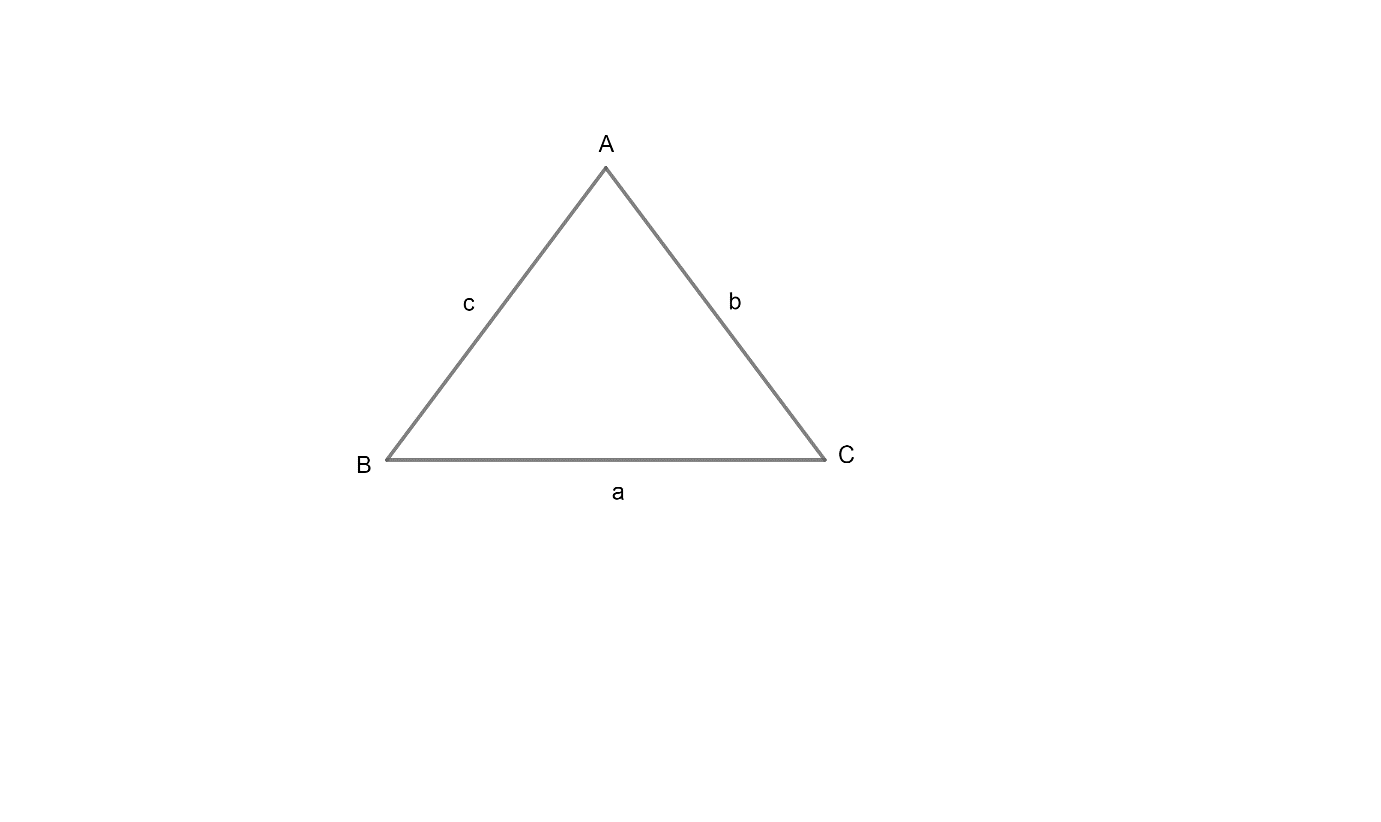
In any $\Delta ABC$, prove that ${{a}^{2}}\sin \left( B-C \right)=\left( {{b}^{2}}-{{c}^{2}} \right)\sin A$.
Answer
578.4k+ views
Hint: We will be using the concept of solution of triangles to solve the problem. We will use the sine rule to relate the sides a and c with the sine of angle A and C and similarly we will find the relation between the sides a and b then we will use these equations in the left hand side of the equation.
Complete Step-by-Step solution:
We have been given a$\Delta ABC$ and we have to prove that, ${{a}^{2}}\sin \left( B-C \right)=\left( {{b}^{2}}-{{c}^{2}} \right)\sin A$.
So, we will first draw a $\Delta ABC$ and label its sides as a, b, c.

Now, we will take L.H.S of the question and prove it to be equal to the R.H.S.
In L.H.S we have,
${{a}^{2}}\sin \left( B-C \right)$
Now, we know that the trigonometric identity that,
$\sin \left( A-B \right)=\sin A\cos B-\cos A\sin A$
So, we have,
${{a}^{2}}\sin \left( B-C \right)={{a}^{2}}\sin B\cos C-{{a}^{2}}\cos B\sin C$
Now, we know that according to sine rule,
$\dfrac{\sin A}{a}=\dfrac{\sin B}{b}=\dfrac{\sin C}{c}=k$
So, we have,
$\begin{align}
& a\sin C=c\sin A..........\left( 1 \right) \\
& a\sin B=b\sin A..........\left( 2 \right) \\
\end{align}$
Now, we will use (1) and (2) in,
${{a}^{2}}\sin B\cos C-{{a}^{2}}\cos B\sin C$
So, we have,
$\begin{align}
& {{a}^{2}}\sin \left( B-C \right)=ab\sin A\cos C-ac\cos B\sin A \\
& =a\sin A\left( ab\cos C-ac\cos B \right) \\
\end{align}$
Now, we know that according to cosine rule we have,
$\begin{align}
& \cos C=\dfrac{{{a}^{2}}+{{b}^{2}}-{{c}^{2}}}{2ab}.........\left( 3 \right) \\
& \cos B=\dfrac{{{c}^{2}}+{{a}^{2}}-{{b}^{2}}}{2ac}.........\left( 4 \right) \\
\end{align}$
Now, using (3) and (4) above we have,
$\begin{align}
& {{a}^{2}}\sin \left( B-C \right)=\sin A\left( ab\dfrac{\left( {{a}^{2}}+{{b}^{2}}-{{c}^{2}} \right)}{2ab}-ac\dfrac{\left( {{c}^{2}}+{{a}^{2}}-{{b}^{2}} \right)}{2ac} \right) \\
& =\sin A\left( \dfrac{{{a}^{2}}+{{b}^{2}}-{{c}^{2}}}{2}-\dfrac{\left( {{c}^{2}}+{{a}^{2}}-{{b}^{2}} \right)}{2} \right) \\
& =\sin A\left( \dfrac{{{a}^{2}}+{{b}^{2}}-{{c}^{2}}-{{c}^{2}}-{{a}^{2}}+{{b}^{2}}}{2} \right) \\
\end{align}$
Now, we will further simplify the numerator,
$\begin{align}
& =\sin A\left( \dfrac{2{{b}^{2}}-2{{c}^{2}}}{2} \right) \\
& =\sin A\left( {{b}^{2}}-{{c}^{2}} \right) \\
& {{a}^{2}}\sin \left( B-C \right)=\left( {{b}^{2}}-{{c}^{2}} \right)\sin A \\
\end{align}$
Since L.H.S = R.H.S, Hence proved.
Note: To solve these types of questions it is important to note that we have used the projection formulae of the triangle to find the relation in equation (1) and (2) as follows.
$\begin{align}
& a\sin C=c\sin A..........\left( 1 \right) \\
& a\sin B=b\sin A..........\left( 2 \right) \\
\end{align}$
also it is important to note that we have used the trigonometric identity that $\sin \left( A-B \right)=\sin A\cos B-\cos A\sin A$ to further simplify the left hand side of the equation.
Complete Step-by-Step solution:
We have been given a$\Delta ABC$ and we have to prove that, ${{a}^{2}}\sin \left( B-C \right)=\left( {{b}^{2}}-{{c}^{2}} \right)\sin A$.
So, we will first draw a $\Delta ABC$ and label its sides as a, b, c.

Now, we will take L.H.S of the question and prove it to be equal to the R.H.S.
In L.H.S we have,
${{a}^{2}}\sin \left( B-C \right)$
Now, we know that the trigonometric identity that,
$\sin \left( A-B \right)=\sin A\cos B-\cos A\sin A$
So, we have,
${{a}^{2}}\sin \left( B-C \right)={{a}^{2}}\sin B\cos C-{{a}^{2}}\cos B\sin C$
Now, we know that according to sine rule,
$\dfrac{\sin A}{a}=\dfrac{\sin B}{b}=\dfrac{\sin C}{c}=k$
So, we have,
$\begin{align}
& a\sin C=c\sin A..........\left( 1 \right) \\
& a\sin B=b\sin A..........\left( 2 \right) \\
\end{align}$
Now, we will use (1) and (2) in,
${{a}^{2}}\sin B\cos C-{{a}^{2}}\cos B\sin C$
So, we have,
$\begin{align}
& {{a}^{2}}\sin \left( B-C \right)=ab\sin A\cos C-ac\cos B\sin A \\
& =a\sin A\left( ab\cos C-ac\cos B \right) \\
\end{align}$
Now, we know that according to cosine rule we have,
$\begin{align}
& \cos C=\dfrac{{{a}^{2}}+{{b}^{2}}-{{c}^{2}}}{2ab}.........\left( 3 \right) \\
& \cos B=\dfrac{{{c}^{2}}+{{a}^{2}}-{{b}^{2}}}{2ac}.........\left( 4 \right) \\
\end{align}$
Now, using (3) and (4) above we have,
$\begin{align}
& {{a}^{2}}\sin \left( B-C \right)=\sin A\left( ab\dfrac{\left( {{a}^{2}}+{{b}^{2}}-{{c}^{2}} \right)}{2ab}-ac\dfrac{\left( {{c}^{2}}+{{a}^{2}}-{{b}^{2}} \right)}{2ac} \right) \\
& =\sin A\left( \dfrac{{{a}^{2}}+{{b}^{2}}-{{c}^{2}}}{2}-\dfrac{\left( {{c}^{2}}+{{a}^{2}}-{{b}^{2}} \right)}{2} \right) \\
& =\sin A\left( \dfrac{{{a}^{2}}+{{b}^{2}}-{{c}^{2}}-{{c}^{2}}-{{a}^{2}}+{{b}^{2}}}{2} \right) \\
\end{align}$
Now, we will further simplify the numerator,
$\begin{align}
& =\sin A\left( \dfrac{2{{b}^{2}}-2{{c}^{2}}}{2} \right) \\
& =\sin A\left( {{b}^{2}}-{{c}^{2}} \right) \\
& {{a}^{2}}\sin \left( B-C \right)=\left( {{b}^{2}}-{{c}^{2}} \right)\sin A \\
\end{align}$
Since L.H.S = R.H.S, Hence proved.
Note: To solve these types of questions it is important to note that we have used the projection formulae of the triangle to find the relation in equation (1) and (2) as follows.
$\begin{align}
& a\sin C=c\sin A..........\left( 1 \right) \\
& a\sin B=b\sin A..........\left( 2 \right) \\
\end{align}$
also it is important to note that we have used the trigonometric identity that $\sin \left( A-B \right)=\sin A\cos B-\cos A\sin A$ to further simplify the left hand side of the equation.
Recently Updated Pages
Change the affirmative sentence into a negative sentence class 10 english CBSE

Find the equation of a circle passing through the origin class 10 maths CBSE

Identify and correct the errors in the following sentence class 10 english CBSE

A bag contains 5 red balls and some blue balls If -class-10-maths-CBSE

What was the cause of FrancoGerman rivalry class 10 social science CBSE

Why would you call Asia a continent of contrasts class 10 social studies CBSE

Trending doubts
Why is there a time difference of about 5 hours between class 10 social science CBSE

Tropical deciduous trees shed their leaves in the dry class 10 social science CBSE

The Equation xxx + 2 is Satisfied when x is Equal to Class 10 Maths

Write a letter to the principal requesting him to grant class 10 english CBSE

The uses of bleaching powder are A It is used bleaching class 10 chemistry CBSE

Leap year has days A 365 B 366 C 367 D 368 class 10 maths CBSE




